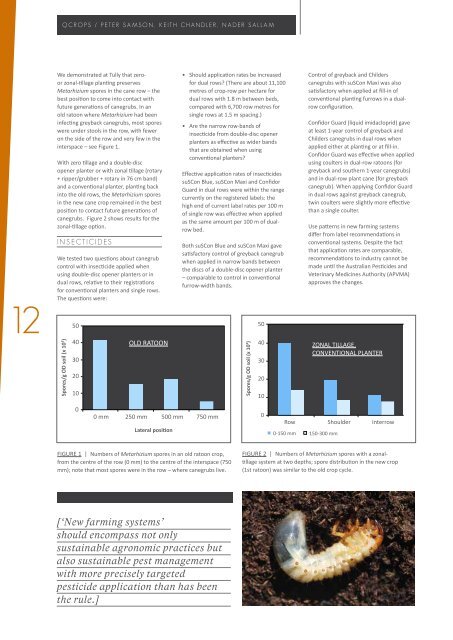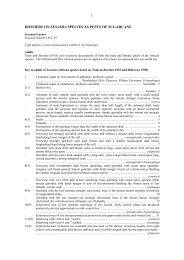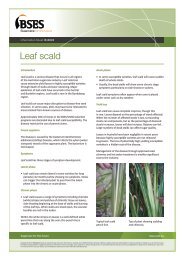Create successful ePaper yourself
Turn your PDF publications into a flip-book with our unique Google optimized e-Paper software.
12<br />
QCrOps / peTer sAMsON, keiTh ChANDLer, NADer sALLAM<br />
We demonstrated at Tully that zero-<br />
or zonal-tillage planting preserves<br />
Metarhizium spores in the cane row – the<br />
best position to come into contact with<br />
future generations of canegrubs. In an<br />
old ratoon where Metarhizium had been<br />
infecting greyback canegrubs, most spores<br />
were under stools in the row, with fewer<br />
on the side of the row and very few in the<br />
interspace – see figure 1.<br />
With zero tillage and a double-disc<br />
opener planter or with zonal tillage (rotary<br />
+ ripper/grubber + rotary in 76 cm band)<br />
and a conventional planter, planting back<br />
into the old rows, the Metarhizium spores<br />
in the new cane crop remained in the best<br />
position to contact future generations of<br />
canegrubs. figure 2 shows results for the<br />
zonal-tillage option.<br />
iNseCTiCiDes<br />
We tested two questions about canegrub<br />
control with insecticide applied when<br />
using double-disc opener planters or in<br />
dual rows, relative to their registrations<br />
for conventional planters and single rows.<br />
The questions were:<br />
Spores/g OD soil (x 10 3 )<br />
50<br />
40<br />
30<br />
20<br />
10<br />
0<br />
OlD RATOON<br />
0 mm <strong>25</strong>0 mm 500 mm 750 mm<br />
Lateral position<br />
• Should application rates be increased<br />
for dual rows? (There are about 11,100<br />
metres of crop-row per hectare for<br />
dual rows with 1.8 m between beds,<br />
compared with 6,700 row metres for<br />
single rows at 1.5 m spacing.)<br />
• Are the narrow row-bands of<br />
insecticide from double-disc opener<br />
planters as effective as wider bands<br />
that are obtained when using<br />
conventional planters?<br />
fIGuRE 1 | Numbers of Metarhizium spores in an old ratoon crop,<br />
from the centre of the row (0 mm) to the centre of the interspace (750<br />
mm); note that most spores were in the row – where canegrubs live.<br />
[‘New farming systems’<br />
should encompass not only<br />
sustainable agronomic practices but<br />
also sustainable pest management<br />
with more precisely targeted<br />
pesticide application than has been<br />
the rule.]<br />
Effective application rates of insecticides<br />
suSCon Blue, suSCon Maxi and Confidor<br />
Guard in dual rows were within the range<br />
currently on the registered labels: the<br />
high end of current label rates per 100 m<br />
of single row was effective when applied<br />
as the same amount per 100 m of dual-<br />
row bed.<br />
Both suSCon Blue and suSCon Maxi gave<br />
satisfactory control of greyback canegrub<br />
when applied in narrow bands between<br />
the discs of a double-disc opener planter<br />
– comparable to control in conventional<br />
furrow-width bands.<br />
Spores/g OD soil (x 10 3 )<br />
50<br />
40<br />
30<br />
20<br />
10<br />
0<br />
Control of greyback and Childers<br />
canegrubs with suSCon Maxi was also<br />
satisfactory when applied at fill-in of<br />
conventional planting furrows in a dualrow<br />
configuration.<br />
Confidor Guard (liquid imidacloprid) gave<br />
at least 1-year control of greyback and<br />
Childers canegrubs in dual rows when<br />
applied either at planting or at fill-in.<br />
Confidor Guard was effective when applied<br />
using coulters in dual-row ratoons (for<br />
greyback and southern 1-year canegrubs)<br />
and in dual-row plant cane (for greyback<br />
canegrub). When applying Confidor Guard<br />
in dual rows against greyback canegrub,<br />
twin coulters were slightly more effective<br />
than a single coulter.<br />
use patterns in new farming systems<br />
differ from label recommendations in<br />
conventional systems. Despite the fact<br />
that application rates are comparable,<br />
recommendations to industry cannot be<br />
made until the Australian Pesticides and<br />
Veterinary Medicines Authority (APVMA)<br />
approves the changes.<br />
ZONAl TIllAGE,<br />
CONVENTIONAl PlANTER<br />
Row Shoulder Interrow<br />
0-150 mm 150-300 mm<br />
fIGuRE 2 | Numbers of Metarhizium spores with a zonaltillage<br />
system at two depths; spore distribution in the new crop<br />
(1st ratoon) was similar to the old crop cycle.




